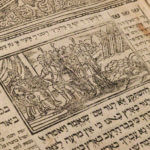It is well known in all the lands of exile that the printing coming from Venice is the most correct and accurate of all printing done today anywhere on earth. Rabbi Abraham ibn Migas, Istanbul, 16th cent.
The centrality of Italy and its importance for the printing revolution cannot be exaggerated. Already in the late fifteenth century, many cities in Italy—especially Venice—rapidly became the most important centers of the new industry. In his book on printing in Renaissance Italy, Brian Richardson states:
“The introduction of the printing press in the peninsula, in or shortly before 1465, had profound consequences for all users of the written word. Books became available in much larger quantities than before, they cost much less, and texts could thus be disseminated more quickly and more widely. The sale of copies of a text could also be controlled, in principle, to the benefit of its author. Texts in printed books were presented differently in some respects from those in manuscripts, and new texts were produced with new sets of readers in mind.”
All of the above was also true with respect to Hebrew printing. Italy was the center of Hebrew book production from the late fifteenth century through the middle of the sixteenth century and remained one of the most important centers of Jewish printing in the later sixteenth, the seventeenth, and the eighteenth centuries. During this period, of 139 Hebrew incunabola produced by 40 different presses, more than 60 percent were from Italy.
That the quality, sophistication, and novelty of Venetian Hebrew printing considerably surpassed that of other centers, for example, the Ottoman Empire and Eastern Europe, was a view widely held among early modern Jewish intellectuals and their readers.
Italy was home to innovative printer-publishers like Gershom Soncino and Daniel Bomberg, who made major advances in Hebrew printing both in terms of typography and format.
Centers of particular industries tend to attract talent and in turn produce more. The printing industry in Italy demanded talent—skilled editors, typesetters, proofreaders, and printers—and capital to produce books; Italy both attracted talent and capital and produced more of it. Its importance was magnified by its geographic position in the Jewish world.
The Jews of northern Italy traded with Jews throughout the early modern Jewish world, from Germany and Poland-Lithuania to the Ottoman Empire and North Africa, by way of ports in Venice and other cities and inland routes across the Alps. Books printed in Italy circulated to all these areas, and books printed in the farther reaches of Jewish settlement made their way to Italy.
Moreover, northern Italy drew experts from a wide variety of Jewish communities—Iberia, southern France, southern Italy, former Byzantine lands, Germany, and the Middle East—who brought with them their medieval traditions and manuscripts, leading to rich possibilities for textual production and publication.
Italy continued to be an important print center into the later seventeenth and eighteenth centuries, although it was no longer dominant—the locus of Hebrew and Yiddish printing had shifted to Amsterdam and other areas in the Ashkenazi kulturbereich.
Benozzo Gozzoli, Cosimo de' Medici, Palazzi Medici Riccardi, Florence; Map of Venice, Vatican Museums, Rome; Tiziano, Isabella d'Este, Kunsthistorisches Museum, Vienna; Paolo Veronese, Sultan Bajezid, Collection Bayerische Staatsgemäldesammlungen, München; Giovanni Bellini, Doge Leonardo Loredan, National Gallery, London
References: Marvin J. Heller, Further Studies in the Making of the Early Hebrew Book, 2013, Giuliano Tamani, Di alcuni stampatori in ebraico a Venezia nei secoli XVI-XVII-XVIII, 2015, Joseph R. Hacker (Editor), Adam Shear (Editor), The Hebrew Book in Early Modern Italy, 2011



